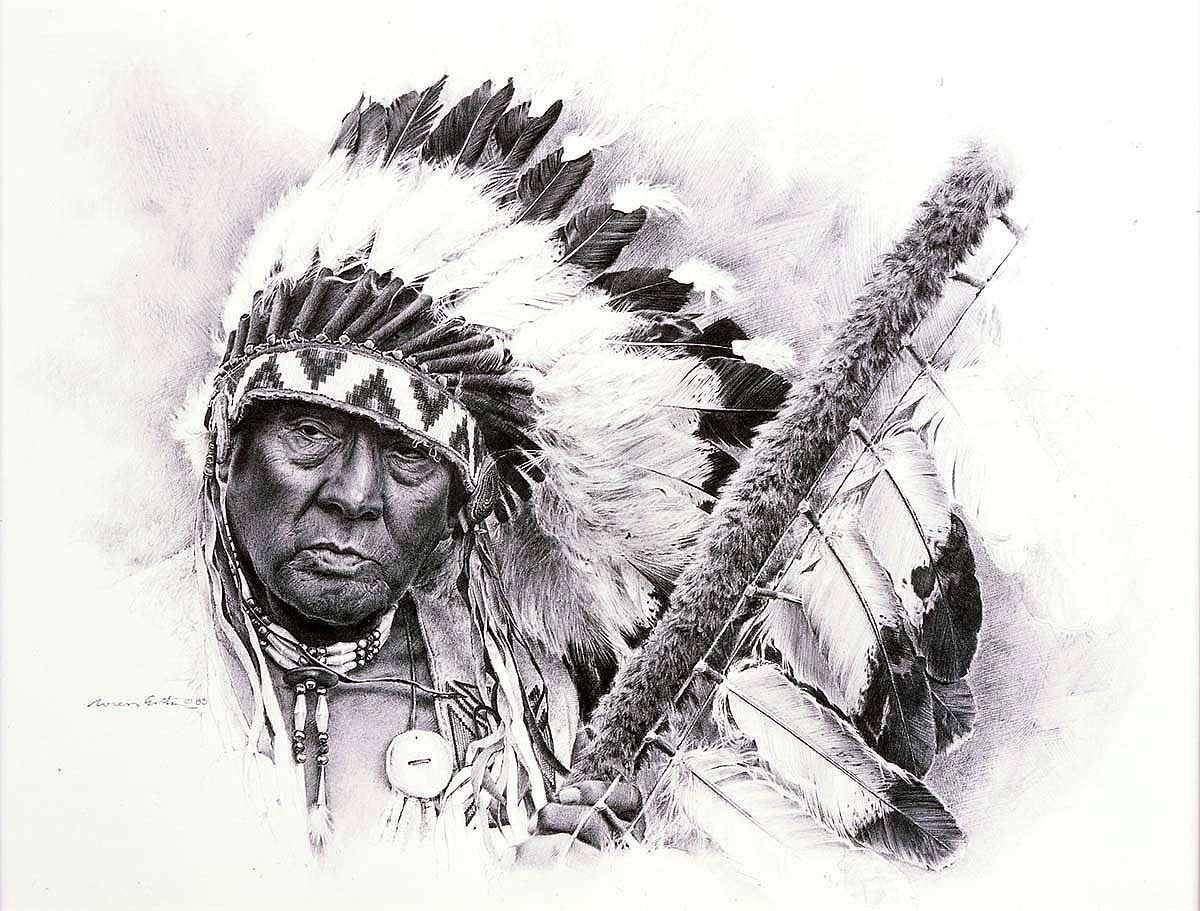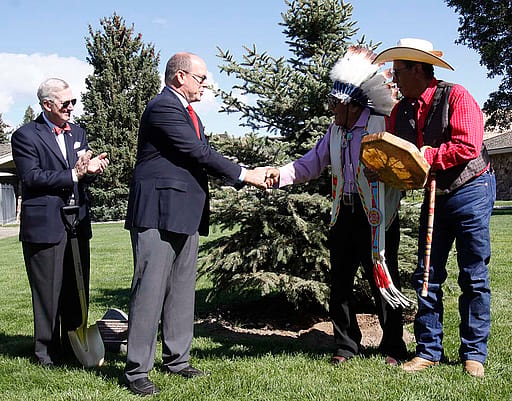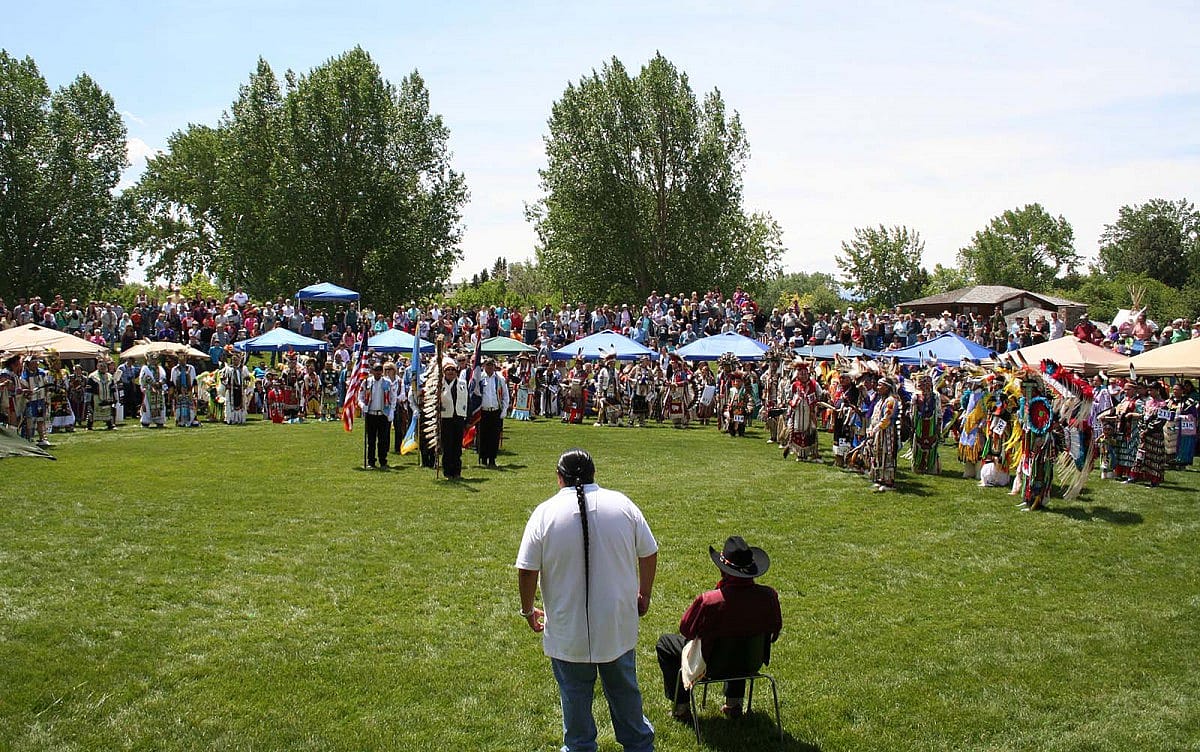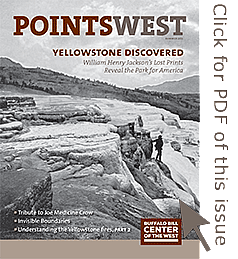
A Tribute to Joe Medicine Crow – Points West Online
Originally published in Points West magazine
Summer 2016
Making History: A Tribute to Joe Medicine Crow
By Rebecca West
Following the April 3, 2016, death of Dr. Joe Medicine Crow, Plains Indian Museum Curator Rebecca West posted a tribute. On the eve of the 38th Annual Plains Indian Museum Powwow in 2019, we share it again. Medicine Crow was a tribal historian, noted Crow scholar, member of the Plains Indian Museum Advisory Board, and a longtime friend to the Buffalo Bill Center of the West.
History is not made simply by passages of entry and exit into this world. History is an accumulation of one’s life experiences and interplay of all types of beings—humans, animals, and otherwise—along with elements of the natural world, and forces that we cannot control.
Sunday April 3, 2016, marked the passage of Joe Medicine Crow, who made history not by leaving this earth at the age of 102, but by creating history through the amazing deeds, thoughts, and words through his lifetime. Joe had experiences that most of us cannot imagine or grasp as reality. Often when elders pass, we say, “Oh, the changes he must have seen…” Joe was not just seeing these changes; he was making these changes. This was his life.

Whether it was completing four unbelievably courageous war deeds during World War II to earn the honor of war chief; achieving advanced college degrees; accepting the Presidential Medal of Freedom; or sharing his amazing talent for scholarship and oral histories of the Crow Tribe, his accomplishments more than filled one lifetime. The news coverage of his death has eloquently and accurately portrayed Joe’s accolades, but there are details of his contributions to the Plains Indian Museum of the Buffalo Bill Center of the West that aren’t as well known, but significant nonetheless.
Joe was one of the founding members of the Center’s Plains Indian Museum Advisory Board, formed on June 18, 1976. It was one of the first museums in the nation (if not the first) to include American Indians as board members to represent their respective cultures in the formation of a museum. Joe and other advisors worked with the board’s building committee, architects, educators, and consultants to design the physical space of the Plains Indian wing, as well as create the intellectual and cultural contents of its exhibitions. The Plains Indian Museum opened in 1979.

Some twenty years later, I met Joe, who was still actively participating in Plains Indian Museum Advisory Board meetings, as well as our annual Powwow. In 1996, we began to discuss an update to the Plains Indian Museum. Technologies had changed; audiences were growing; and it was time to draw upon the knowledge of our advisors and others to reinstall, or “reinterpret,” the museum to best use the extensive and precious collections. We still have files overflowing with notes from meetings, conference calls, and lengthy discussions about direction and presentation. Looking back on this time of planning, there were so many voices—and not all were in agreement or supported our efforts to re-awaken what we knew was still a treasure of a museum.
Joe had certain clarity; he often gave the opening blessing at our advisory board meetings and always reminded us of the history of the museum, as well as the need to focus on our future direction. During a conceptual design meeting, shortly after a lunch of soup and sandwiches, Joe provided one such moment of clarity for those privileged enough to hear his overview of “the big picture.” He flipped over his empty soup bowl and explained, not only how we could look at the circular, physical layout of the Plains Indian Museum, but a lot about life. In his words, illustrated by the inverted bowl, he shared, “The circle is actually a dome. Within it is a rich mixture of human experience. It represents holistic harmony.”
A later illustration of Joe’s explanation in the design plans showed Spirituality, Beliefs, and Values at the apex of the dome, with linked spheres of “human experience,” composites of several elements: language, environment, change, seasons, origins, and others, co-existing in a space defined only by its contents. Joe helped us to slow down so that we might listen and think about what we really needed to consider.
Although his hearing began to fail as he approached the 100th year of his life, his mind was sharp, and his heart and voice strong. He sang an honor song, clear and unwavering, for Prince Albert II of Monaco during the Prince’s 2013 visit to the Center. The Buffalo Bill Center of the West awarded Joe the Spirit of the American West Award, an honor which may have paled in comparison to a Presidential Medal of Freedom, but one that he graciously accepted and added to a cache of accolades.
He rarely missed a Powwow here in June and served as the honored elder to perform the pipe invocation. Once he finished his duties in the arena, he would rest for a bit in the shade of the stage and have some coffee (cream and sugar always) and until his most recent years, would dance in the Golden Age Category with the younger participants who were aged 55 and older. He would sit and watch, quietly taking in generations of dancers who were carrying on traditions that he had helped perpetuate.

On one of his final visits to Cody, Joe served as Grand Marshall for the 2015 Buffalo Bill Cody Stampede 4th of July parade. Riding in style, he perched upon the back seat of a cherry red convertible in his eagle feather bonnet and beaded Crow regalia.
Although Joe retired from his board duties, he continued to attend meetings to offer a blessing or tell a great story. His presence was a reminder to us all that we must cherish our elders and all they have to teach us. As you travel to your next lifetime, you have entrusted us with so much to treasure. Thank you, Joe.
Post 242
Written By
Nancy McClure
Nancy now does Grants & Foundations Relations for the Center of the West's Development Department, but was formerly the Content Producer for the Center's Public Relations Department, where her work included writing and updating website content, publicizing events, copy editing, working with images, and producing the e-newsletter Western Wire. Her current job is seeking and applying for funding from government grants and private foundations. In her spare time, Nancy enjoys photography, reading, flower gardening, and playing the flute.










